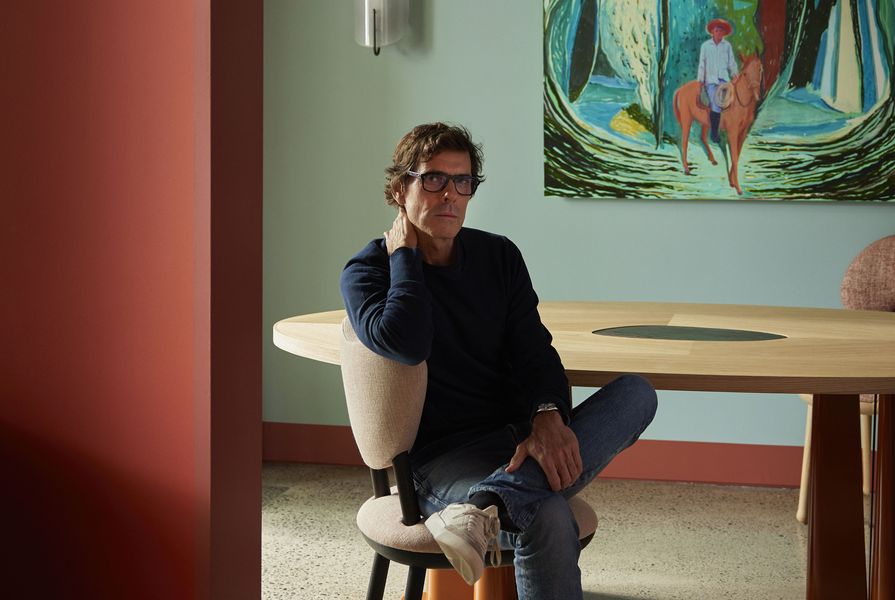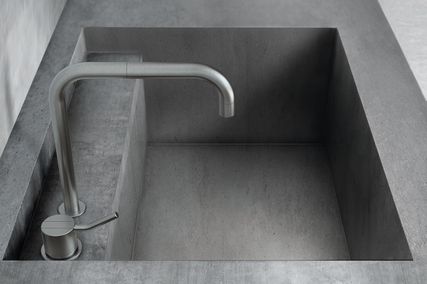“I’m too humble,” replies Pierre Yovanovitch – in his gentle French accent – when I ask about his influence on the collectible design world. Beloved in his native Paris, in New York where his second showroom is located, and increasingly in Australia, the designer has indeed made a mark on the international scene through his oeuvre of characteristically imperfect yet well-crafted spaces and furniture. His latest collection, brought to Australian shores via Criteria gallery in Melbourne, exemplifies his ethos. Criteria’s founder and curator, Rachael Fry, explains: “When Yovanovitch designs, it’s never about perfection – it’s always about detail and he celebrates asymmetry … His shaping either has a connection to nature or to something anthropomorphic; it’s human … The fabrics are always chosen by Pierre, so when you acquire his pieces, you also acquire his full vision.”
Yovanovitch’s oversized Mindy Sofa is a sculptural statement at Criteria gallery. The artwork on the rear wall is by Jules de Balincourt.
Image: Sean Fennessy
Yovanovitch is highly sensitive to his surroundings and draws on them deeply for his work. “For me, everything is inspiration: art, architecture, travelling, light and wind.” He reflects on the impact of his early life: “I was born and raised in Nice, with the sun and the light. We have a special wind in Nice called ‘mistral’ – for me, this is very important because it has so much personality: the sky becomes very blue, the wind cleans everything and then all the details become clear.” Though Yovanovitch moved to Paris to study and work, his connection to home remains strong and integral to his process today. “Fifteen years ago, I bought a very nice house from the seventeenth century, in the middle of nowhere … This is really something I need because I work and travel a lot. I need to go back to see my dog and cat … the nature, the trees, and to smell the forest.” He continues: “I go there to be unproductive, and to be alone.” This makes sense for the introspective designer, who now has a team of 120–150. His aesthetic is directly impacted by his rural home which is made of rustic wood, and by the local galleries displaying art from the 1960s and ’70s.
When asked how he achieves the right balance of perfection and imperfection in his work, Yovanovitch explains: “I’m full of contrasts. I like imperfection, but in a good way, you know, because I like the work to be well done at high quality.” No matter where in the world he is, he will visit the site of his projects to speak with the client. “The imperfection is not by coincidence … and I don’t accept bad quality.”
Pierre Yovanovitch’s Flare Floor Lamps are made of gouged natural solid oak with fabric lampshades.
Image: Courtesy of Criteria
Yovanovitch’s aesthetic has been cultivated through a multidisciplinary design career – initially as a menswear designer for Pierre Cardin, then as an interior architect, and then via Pierre Yovanovitch Mobilier, the furniture company he founded in 2001. While Yovanovitch remains rather self-effacing, when prompted, he does acknowledge his own creative growth: “When I started, my work was more minimal; more white-box; more clean. In the end, I think it wasn’t so interesting … While I have followed what I really liked from the beginning, I have also changed a lot since having my own company … I think being older makes me better; time has helped me to become more creative.” He admits that he’s gained confidence over the years: “in a nice way, I have a natural authority with clients … I think they follow me better because I’m older, and I don’t hesitate because I’m older. When I enter your space, I see very quickly – by intuition – what the flow, the perspective and the light should be. It’s very easy for me now.”
As both an architect and a furniture designer, Yovanovitch considers and traverses scales effortlessly: “When I’m designing a space, I know it will become something I have to furnish.” He explains that he will often sketch pieces that “will be connected to the space and the size of the room.” However, he’s not interested in creating a total “Pierre Yovanovitch” look (befitting his humble nature). “I never do a showroom with all my pieces. I like to mix vintage with other designs, and I like eighteenth-century furniture.” He explains that he aims to achieve balanced spaces through an eclectic mix of new and old furniture and art, that together create the feeling of a family home. “Sometimes, when it’s too clean,” he says “it looks like you’ve over-designed it. But when you mix pieces and colours, then it becomes more natural. That’s what I like.”
For his debut showcase at Criteria gallery, Yovanovitch designed the front area of their new space in his signature warm colour palette, and a combination of his own designs with vintage pieces and fine art. The artwork on the rear wall is by Jules de Balincourt.
Image: Sean Fennessy
This designer is strict about some things, namely quality and craftsmanship. He finds joy in the collaborative process with his makers, and in pushing their limits to make beautiful pieces: “I am looking for craftspeople to make my dreams come true. What I like most is the relationship I have with them, because they’re passionate … I like to help them to go further and to be brave.” Yovanovitch’s solid oak Wave Console is a prime example of his preference for imperfection (organic forms) meeting his standards of perfection (expert woodworking). “I started with solid wood and all the people said it would be very complicated, and that it would move. But I don’t work with vinyl wood because it looks fake. I want deepness in the material and so I pushed the craftspeople to work with a really solid wood … I like wood with cracks – they’re part of life.”
Another of the designer’s intentions – and perhaps the most relatable – is that he wishes to offer comfort and happiness through his work. Yovanovitch speaks sincerely about this, with no hint of taking himself too seriously. “Comfort is very important to me. I like it when people stay in the dining room for hours, you know, to speak and drink and eat. It doesn’t look like it, but I love to eat … I want them to be comfortable and happy. Life has to be happy because it’s short and sometimes hard.” It’s easy to imagine such a dinner party – with guests seated on Yovanovitch’s iconic, perfectly made but whimsical Mr. and Mrs. Oops chairs – the former shaped a bit like a moustache, and the latter like long hair.
Criteria’s founder and curator, Rachel Fry, (left) and Pierre Yovanovitch (right).
Image: Sean Fennessy
Pierre Yovanovitch’s debut Australian solo exhibition is on view at Criteria gallery in Melbourne until 2 May, 2024.






























